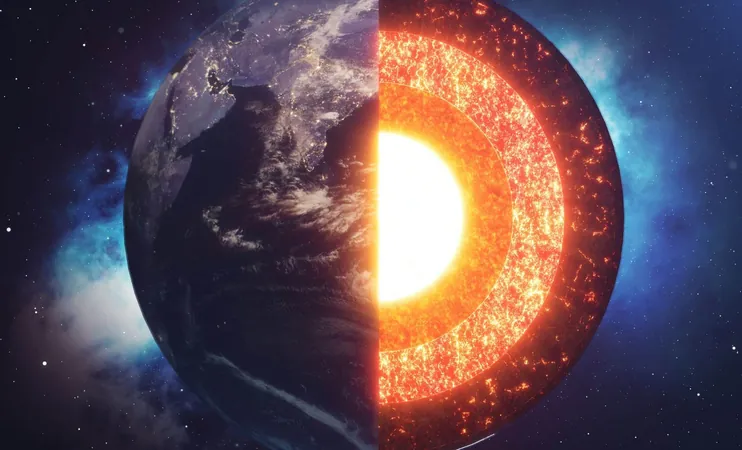
Scientists Unveil Earth's Primitive Face: What Was Our Planet Like Before It Became Recognizable?
2025-03-28
Author: Kai
A Game-Changer in Planetary Science
Traditionally, scientists believed that Earth’s solidification from a turbulent magma ocean to a stable structure occurred gradually and under intense pressures, shaping the chemical composition of the lower mantle—the thick layer above Earth’s core. This research fundamentally challenges these long-standing assumptions, offering a fresh perspective on planet formation not just within our solar system, but potentially beyond.
Understanding Our Chaotic Origins
In the earliest days, Earth was enveloped in a magma ocean, a chaotic and partially molten sea of silicates lying above a molten core. As cooling progressed, crystals began forming in the mantle. Boukaré's team developed a novel physical model that demonstrated these solidifying crystals actually formed at lower pressures near the surface, contrary to previous beliefs that linked them primarily to deep underground conditions.
Boukaré remarks, 'We had largely thought the geochemistry of the lower mantle was dictated by high-pressure reactions. Now we realize we also need to consider low-pressure processes, which could have played a significant role.'
The Impact of Youthful Chaos
Using a multiphase flow approach, the researchers simulated how varying materials in Earth's molten mantle behaved as temperatures dropped. This led to the sinking or floating of solid particles based on their density, ultimately resulting in distinct layer formations each with unique chemical compositions.
The analogy between planetary development and human growth was not lost on Boukaré, who stated, 'Much like children with their abundant energy can act unpredictably, young planets also exhibit chaotic behavior that is mirrored in their current structures.'
Echoes of the Solar Nebula
Fascinatingly, some of the crystal structures observed may reflect conditions predating Earth's full formation, deriving from materials still accumulating from the solar nebula. If true, these geological signatures could be some of the oldest remnants, offering insights into our planet’s initial assembly.
This study doesn't just revise the timeline of Earth's geological evolution; it also implies that other rocky planets might retain analogous clues about their early histories. As our explorations into exoplanets expand, such revelations could pave the way for understanding similar planetary formations.
A Tool for the Future: Predicting Planetary Evolutions
The model developed in this research also links ancient thermal and chemical processes with today’s planetary structures, offering a new framework for predicting the evolutionary paths of other worlds, including those outside our solar system.
Boukaré posits, 'By identifying initial conditions and understanding the fundamental processes of planetary evolution, we can forecast the developmental trajectories of planets.' This capability is vital for assessing the conditions necessary for habitability, internal dynamics, and magnetic field generation—factors crucial for sustaining life on any planet.
Conclusion: Unlocking the Secrets of the Cosmos
With this research, scientists take a significant leap forward in our cosmic narrative, revealing that the tumultuous and energetic beginnings of our planet have left an indelible mark on its geological signature. As we stand on the brink of further explorations into the universe, the mysteries of Earth’s infancy may help illuminate the conditions required for life throughout the cosmos. Stay tuned as we uncover more extraordinary revelations about the universe we call home!

 Brasil (PT)
Brasil (PT)
 Canada (EN)
Canada (EN)
 Chile (ES)
Chile (ES)
 Česko (CS)
Česko (CS)
 대한민국 (KO)
대한민국 (KO)
 España (ES)
España (ES)
 France (FR)
France (FR)
 Hong Kong (EN)
Hong Kong (EN)
 Italia (IT)
Italia (IT)
 日本 (JA)
日本 (JA)
 Magyarország (HU)
Magyarország (HU)
 Norge (NO)
Norge (NO)
 Polska (PL)
Polska (PL)
 Schweiz (DE)
Schweiz (DE)
 Singapore (EN)
Singapore (EN)
 Sverige (SV)
Sverige (SV)
 Suomi (FI)
Suomi (FI)
 Türkiye (TR)
Türkiye (TR)
 الإمارات العربية المتحدة (AR)
الإمارات العربية المتحدة (AR)